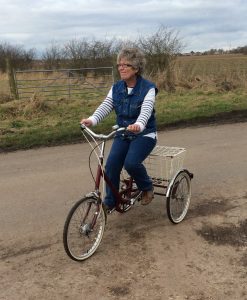Wearing the OTvest™ can Provide Trunk Stability for those with Cerebellar Ataxia.
Experience the increased stability and motor control that wearing an OTvest™ provides. The OTvest™ is a simple, non-invasive intervention that helps treat cerebellar ataxia by improving balance and sense of body position.
Cerebellar ataxia, as well as other movement disorders like Parkinson’s disease, multiple sclerosis, and cerebral palsy, can be treated with the OTvest™ denim weighted vest. Unlike other weighted vests, weighted blankets, or compression vests on the market, the OTvest™ is discreet and looks like normal clothing, allowing for gentle, holistic intervention whenever the wearer chooses.
 The OTvest™ provides deep pressure therapy throughout the shoulder blades (scapula) and across the shoulder-girdle area of the body (upper chest and upper back). Unlike other weighted vests, weighted blankets, or compression vests on the market, the strategic weight positioning within the OTvest™ increases trunk stability, improving balance, upper extremity function, and coordination. When the trunk is stabilized, stabilization in the arms, hands, neck, and head are also improved--as proximal stabilization improves distal control. Wearers with ataxia have reported a decrease in dizziness, and in tremor reduction while wearing the OTvest.
The OTvest™ provides deep pressure therapy throughout the shoulder blades (scapula) and across the shoulder-girdle area of the body (upper chest and upper back). Unlike other weighted vests, weighted blankets, or compression vests on the market, the strategic weight positioning within the OTvest™ increases trunk stability, improving balance, upper extremity function, and coordination. When the trunk is stabilized, stabilization in the arms, hands, neck, and head are also improved--as proximal stabilization improves distal control. Wearers with ataxia have reported a decrease in dizziness, and in tremor reduction while wearing the OTvest.
The weight placement in the OTvest is based upon the Neurodevelopment Treatment created by the world famous British neurologist Karel Bobath and physiotherapist Berta Bobath--who stressed the importance of stabilization of the shoulder-girdle area for movement disorders. This treatment model is used world-wide by occupational and physical therapists still today.
When the upper body is stable, drinking from a cup, combing one’s hair, and keyboarding, are far easier tasks--as proximal control (closer to the body) improves distal function (movement farther from the body- such as hands). For people who experience tremors, as is common in those with cerebellar ataxia, the OTvest™ weight placement can calm anxiety, and help decrease tremors through the application of deep pressure.
Research has shown that weight applied in the shoulder area of persons with cerebellar ataxia, including those with multiple sclerosis, improved their lateral (side-to-side) sway when six pounds of weight was applied (Lucy and Hayes, 1985). Another study demonstrated improvement in lateral sway using even less weight (Widener, Allen, Gibson-Horn, 2009). This research was utilized in the creation of the OTvest™.The OTvest's strategically positioned weights, spread across the upper back and upper chest of the wearer and directly ON the body, calm the wearer, reduce tremors in the body, improve motor function and increase one's awareness of body position through increased proprioception, which helps improve co-ordination. Wearers report a feeling of being "more grounded" and decreased dizziness.
Those who have used the OTvest™ as a treatment for Parkinson’s, a treatment for dystonia, a treatment for ataxia, and other movement disorders, have written letters explaining how much the OTvest™ has benefitted their lives. Here are just a few:
"I received the vest and it is a game changer for me! It is already enabling me to walk much better. I only have to wear [the OTvest] for about an hour and even when I take it off, I am walking better. I am going to recommend it to the ataxia group and write about it on ataxia Australia. Thank you so much for all the work you have put into this. As I said it is a game changer. And the weight is perfect! Vicki Pedler, Queensland, Australia, SCA 6 ataxia
"The vest has been amazing. It has actually made my arms usable again… to play the keyboard. [I] learned that if I wear the vest, I have more use of my more affected left hand, and can isolate the keys better... The dystonic movements are almost gone with the [OTvest™] on." Jennifer Zubko, dystonic adult in Canada (ataxic)
"The OTvest™ makes my feet feel more like they are touching the ground. I feel grounded, more secure when walking." Lili Kazepis, Brooklyn, New York, cerebellar ataxia
"I got the OTvest™ (sic)… and I was able to sleep through the whole night. Usually, I have to take medication but I haven’t had to touch it since I got the vest. The OTvest™ helps me to stabilize my trunk… with the vest, I am able to walk without swaying back and forth and having to hold on and grab things. It helps give me a feeling of security..it helps me get things done." Robin Stevenson, Gainsville, Florida, cerebellar ataxia (quoted from video, linked below)
"In physical therapy, we have been working on stability and core control (with Robin). We have noticed a remarkable difference when walking with the OTvest™ and walking without it. When she first came to physical therapy, she wouldn’t walk in a crowd because she thought she would fall and now she is able to walk through the gym with other patients coming in when she wears the OTvest™. She is far more stable and confident." Eileen Branham, physical therapist, Gainsville, FL (quoted from video, linked below)
"Just received my OTvest™ less than an hour ago. I love it and can already tell I am using my arms better. I am even being more accurate with the keyboard as I sit to type this. My PT and therapeutic riding instructor have been working very hard on my shoulders and arms this week, as they were extremely tight. I put on the vest and they went immediately limp. It is as if I don't have any tone at all in that area, which of course, has calmed my whole system down. The vest feels very much like my therapist's hands constantly on my shoulders. First impressions are that I love it! I don't want to take it off!" Thank you for everything. Jennifer Zubko Canada, dystonia
"The vest seems to keep me straight not going to one side like I do. It makes me walk more straight without leaning towards one side. I am 50, had Ataxia SCA1 since 38, 130 pounds, wear 10 or 12. The vest has the 3 pounds... It works good with keeping me more balanced and grounded. My muscles are very weak and sore from the ataxia. I also can't button things. The snaps work great." Cathy Letson, Sca 1 ataxia, Claxton, GA 6/16
"Dear OTvest,

Robin, who has cerebellar ataxia, began wearing the OTvest weighted vest, hoping that it would reduce her lateral sway. The OTvest™ provides such an effective treatment for cerebellar ataxia in her case that Robin no longer needs to hold onto a wall or depend on support from her physical therapist when she wears the OTvest™. She also experienced improvement in her nightly sleep after wearing the OTvest prior to going to bed. Robin’s before and after experience wearing the weighted vest is recorded and demonstrated in the video below:
In this video, Robin is wearing an OTvest size medium with 4lbs of weight.
Place an order by clicking here.
Look for the yellow "OTvest™" label on the chest pocket to make sure you are getting the genuine OTvest™. Others may look like the OTvest™ from the outside, but the weight placement is important. Only the OTvest™ has the patented weighted insert with weight lying directly upon the body. This makes the difference!
Note: The OTvest™ is not recommended for those with spinal cord problems and the accompanying balance problems associated with those disorders, such as herniated or dislocated discs, degenerative disc disease, or other spinal cord injuries. The balance problems that benefit from the OTvest™ weighted vest are those with upper motor neuron and/or cerebellar problems described in the first paragraph. Recommended to use under supervision of an occupational and/or physical therapist.
References:
Chase RA, Cullen JK, Sullivan SA. Modification of intention tremor in man. Nature 1965; 4983:485-7.
Clopton N, Schultz D, Boren C, Porter J, Brillhart T. Effects of axial loading on gait for subjects with cerebellar ataxia: preliminary findings. Neurol Report 2003;27:15-21.
Gillen, G. (2000). Improving activities of daily living performance in an adult with ataxia. American Journal of Occupational Therapy (54)1:89-94.
Hewer RL, Cooper R, Morgan MH. An investigation into the value of treating intention tremor by weighting the affected limb. Brain 1972;95:570-90.
Lucy SD, Hayes KC. Postural sway profiles: normal subjects and subjects with cerebellar ataxia. Physiother Can 1985;37: 140-8.
Morgan MH, Hewer RL, Cooper R. Application of an objective method of assessing intention tremor–a further study on the use of weights to reduce intention tremor. J Neurol Neurosurg Psychiatry 1975;38:259-64.
Morgan MH. Ataxia and weights, Physiotherapy 1975;61: 332-4.
Widener GL, Allen DD, Gibson-Horn C. Balance-based torso-weighting may enhance balance in persons with multiple sclerosis: preliminary evidence. Arch Phys Med Rehabil 2009;90:602-9.
